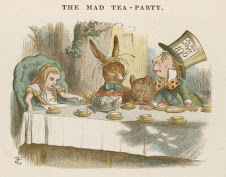One long standing point of consensus among political scientists is that Independent voters do not exist. For some background on this issue, see any number of past posts here at Politea:
• Dispel the Myth of the Myth of the Independent Voter from August 2009
• On the Myth of the Myth of the Independent Voter from December 2009
• Debunking the Myth of the Independent Voter from November 2010
• An Anatomy of an Anti-Independent Hit Piece from April 2011
• A Conscientious Objection to Political "Science" from August 2011
In a new post at The FreeStater Blog, Todd Eberly, an assistant professor of political science at St. Mary's College of Maryland, makes a point that should be very familiar to regular readers here at Politea in a post entitled, "The "Myth" of the Myth of the Independent Voter." Excerpt:
much of the research on independent voters considers partisanship in a single election and rarely follows the same voters across multiple elections. When voters are followed across elections, the focus tends to be on presidential elections . . .Read the whole thing.
Are Independents independent in name only? No, not really . . . In a 2009 article in Electoral Studies, political scientist John Petrocick argued, “Leaners are partisans. Characterizing them as independents underestimates the partisanship of Americans…” Indeed, Petrocik penned the foundational research on leaners in 1974 and his conclusions that leaners were every bit as partisan as their more partisan counterparts has influence much scholarship since. But a recent conference paper by Drew Kurlowski identified significan flaws in Petrocik initial work. Research that I have been conducting suggests independent partisans are far more independent than Abramowitz, Mellman or others realize.
Most studies of partisanship often consider the views of leaners at a given point in time or their votes in a specific election or examine the stability of partisan identification by merging all partisans – Strong, Weak, or Leaning – together and measure macro-level party identification. These measure do not take into consideration the temporal nature of partisan attachment and the propensity to change party affiliation over time . . .But the larger question really pertains to the size and stability of a governing coalition over time. For a President or a political party to succeed they must have a stable electoral coalition. If independent voters are the fastest growing segment of the electorate and if they are truly independent, then Democrats and Republicans need to worry about the rising number of independent partisans. But if folks like Mark Mellman are correct, then the parties can ignore the threat of the independent voter.A review of ANES data from a panel survey that included 2000, 2002, and 2004, shows that independent Democrats and independent Republicans (roughly a third of each party) are much less attached to their party than either Weak or Strong partisans over time . . .Mellman and others are correct - independent Partisans do vote much like their Strong Partisan counterparts in a given election, but the ANES panel data suggests that a significant share of independent Partisans (between a quarter and a third) may well have a different partisan stripe by the next election cycle.
Fully 11% of the electorate are Pure independents, another 30% are independent Partisans (about 18% Democrats and 12% Republicans) and between 25% and 30% of these independent Partisans switch self-reported party affiliation and 25% to 45% change their party vote from election to election. At the very least, this suggests a 25% voting bloc that is quite volatile, quite independent - in a country where our presidential elections have been decided by margins of 7 percentage points or less since 2000 and the difference between the national two party vote share in House elections has averaged about 5 percentage points since 1990.
Independent voters are no myth, they matter, and (when you include among them independent Partisans) they absolutely sway elections. Indeed, the present and highly competitive political era in which we are living is a direct result of a decrease in partisan attachment among a growing number of voters.


No comments:
Post a Comment